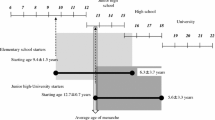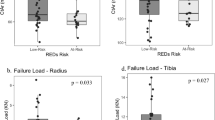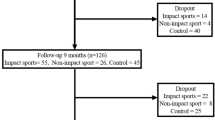Abstract
The purpose of this cross-sectional study was to investigate the influence of two different types of weight-bearing activity, muscle strength, and body composition on bone mineral density (BMD), bone mineral content (BMC), and bone area in three different groups of late adolescent girls. The first group consisted of 10 females participating in competitive rope-skipping (age 17.8 ± 0.8 years) training for 6.7 ± 3.1 hours/week; the second group consisted of 15 soccer players (age 17.4 ± 0.8 years) training for 6.1 ± 2.0 hours/week; and the third group consisted of 25 controls (age 17.6 ± 0.8 years) with physical activity of 0.9 ± 1.1 hours/week. The groups were matched for age, height, and weight. BMD (g/cm2), BMC (g), and bone area (cm2) of the total body, lumbar spine, hip, total femur, distal femur, diaphyses of femur and tibia, proximal tibia, and humerus were measured using dual-energy X-ray absorptiometry (DXA). Bone density was also assessed in the radial forearm site of the dominant limb in the rope skippers and in 10 matched controls. The rope skippers had 22% higher BMD at the ultradistal site (P < 0.01). Both high-activity groups had significantly higher BMD (P < 0.05) at most loaded sites compared with the control group. When adjusting for differences in lean mass and starting age of sport-specific training between the activity groups, the rope-skipping group had a higher BMD of the total body, lumbar spine, and right humerus compared with the soccer group. They also had a significantly higher bone area of the total body, total femur, and the proximal femur than both other groups, and a significantly higher bone area of the tibia diaphysis, compared with the soccer group. In a multivariate analysis among all subjects (n = 50), all BMD sites, except the femur diaphysis, distal femur, and proximal tibia, were significantly related to type of physical activity (β= 0.25–0.43, P < 0.05). The bone area values at different sites were strongly related to muscle strength and parameters related to body size [height, weight, lean mass, fat mass, and body mass index (BMI)]. In conclusion, it appears that in late adolescent women, weight-bearing activities are an important determinant for bone density, and high impact activities such as jumping also seem to be associated with a modification of the bone geometry (hence, the bone width) at the loaded sites.
Similar content being viewed by others
Author information
Authors and Affiliations
Additional information
Received: 28 June 1999 / Accepted: 22 March 2000
Rights and permissions
About this article
Cite this article
Pettersson, U., Nordström, P., Alfredson, H. et al. Effect of High Impact Activity on Bone Mass and Size in Adolescent Females: A Comparative Study Between Two Different Types of Sports. Calcif Tissue Int 67, 207–214 (2000). https://doi.org/10.1007/s002230001131
Published:
Issue Date:
DOI: https://doi.org/10.1007/s002230001131




